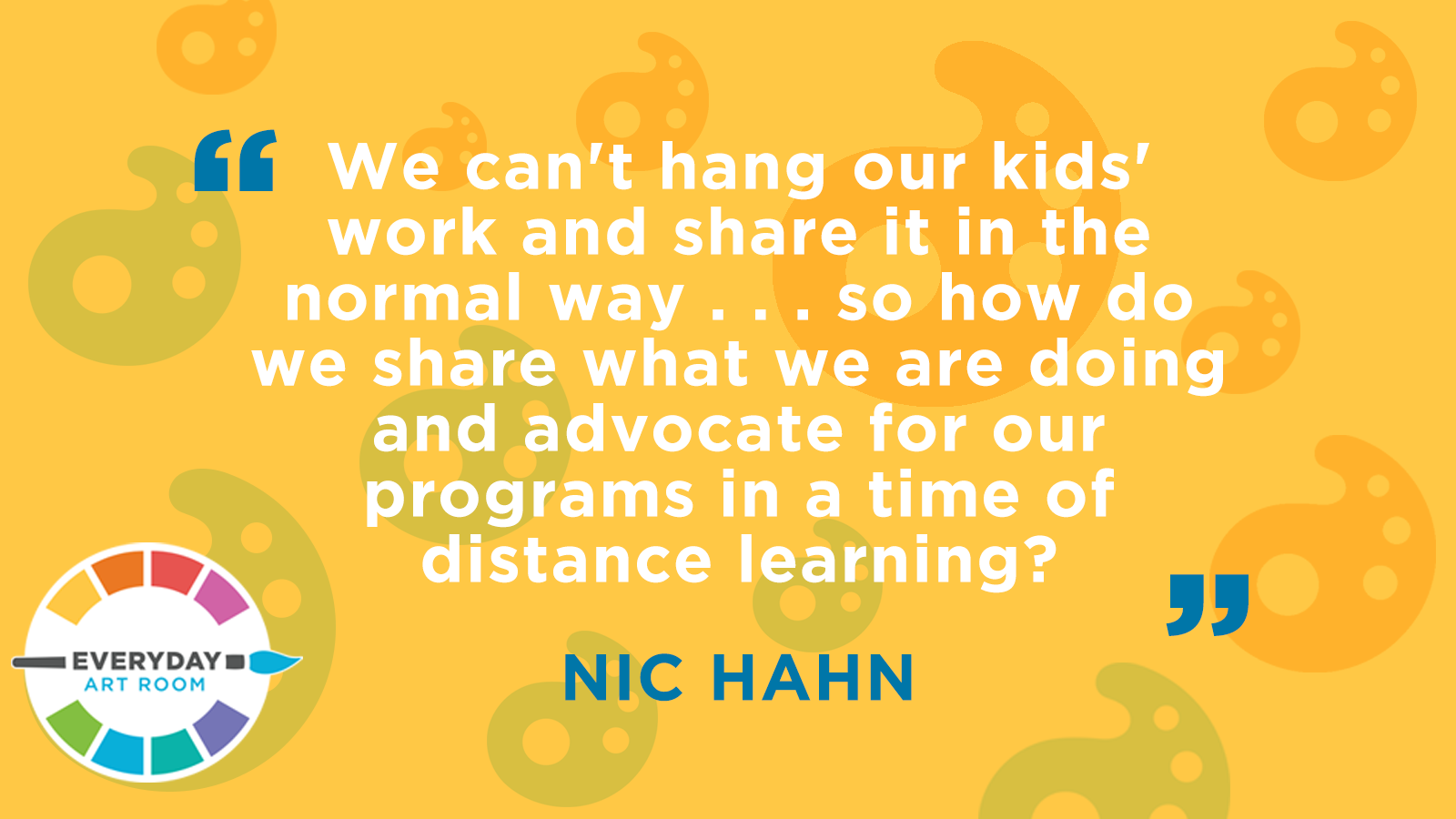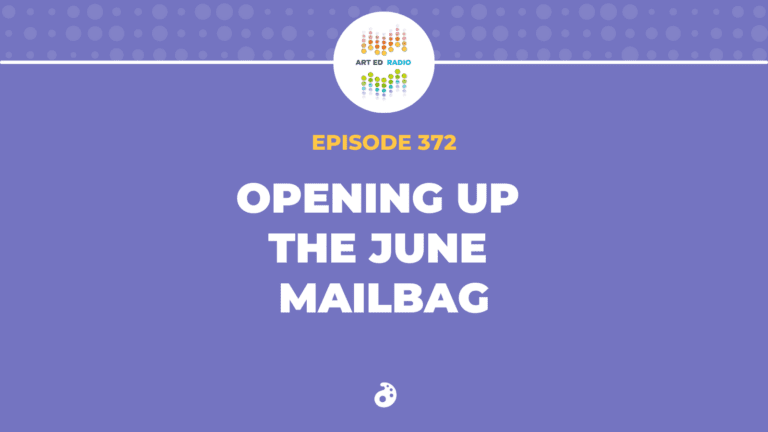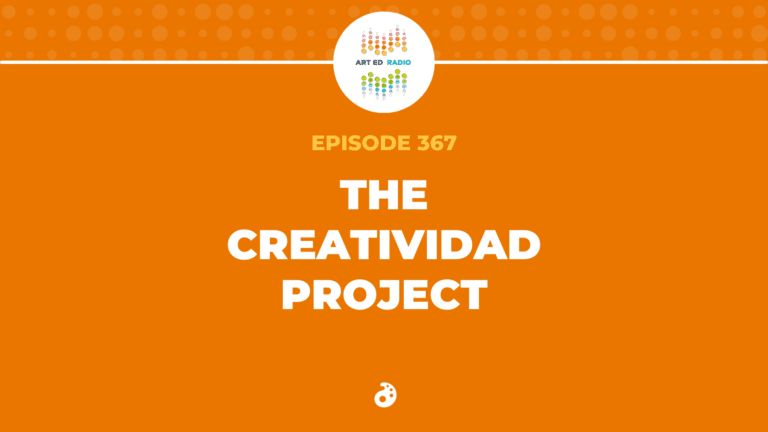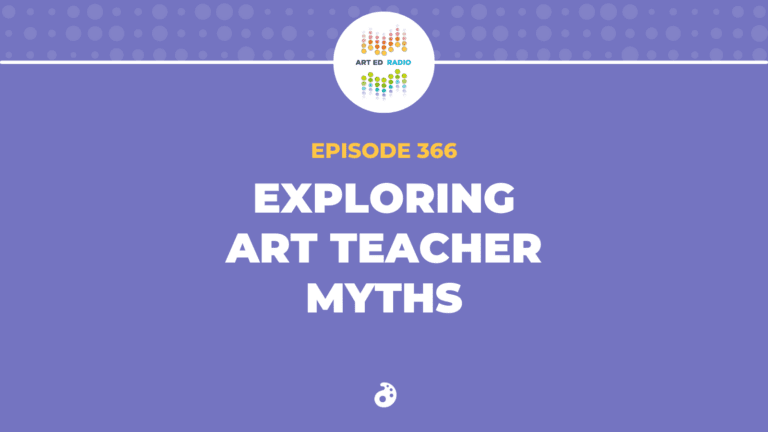Teaching looks incredibly different right now, but as art teachers, we have the ability to continue to share the visual content that develops in our room. In today’s episode, Nic discusses how we can continue with our advocacy and share the work of our students in a time of distance learning. Full Episode Transcript Below.
Resources and Links
- View all of AOEU’s resources to help with distance learning
- See how Nic’s students post a FlipGrid response
- Why You Should Use Social Media as an Advocacy Tool
- 10 Arts Advocacy Resources Every Teacher Needs to Know

Transcript
Nic: Visual art teachers are extremely lucky when it comes to advocating for their program. We are visual art teachers, which means that all we have to do is hang our art to really let people know what is happening in our classroom. We just need to make it visible. Well, in digital teaching and learning, this changes quite a bit. If we hang something on the wall, no one’s going to see it. Our students aren’t in our classroom, so we’re not able to take their work and share it in the traditional ways that we have done in the past. So how do you share an advocate for your program while digitally teaching and learning? Let’s talk about that today on Everyday Art Room. This is your host, Nic Hahn.
Boy, being an art teacher lately has definitely changed, right? I mean, think about your job prior to this whole distance learning and COVID-19 situation. We would advertise what we were doing in our classroom in a number of ways. We would hang up our artwork throughout the school. That was an amazing way to advocate for your program. Everybody knew not only what their grade was working on, but other grades in the school, they would see a variety of artworks, know that there is a range of quality that is being hung in display. They would get to see the concepts that were covered because you’d have a little plaque beside it explaining all the depth of your lesson. People would come in to your setting because of concerts or other events, maybe you have a carnival or something that was coming up, or conferences. Man, don’t you have everything hanging on the wall just perfect ready to invite all those parents to come through the hallways because you know that this is your chance to advocate for your program and share what you’ve been doing?
I mean, most of those events were social events. Or, even if you were a person who submitted artwork throughout the community, you hung it in the local library or in local businesses, that was a social thing that you created for people to see in your community. Another thing that you might have done is created art shows and made a huge event of just the art that you were presenting. Maybe you worked with the music department and had a concert at the same time. No matter what you probably did in-house, you’re not able to do this any more. Sharing your artwork looks different right now because we are a digital teaching, digital learning community right now.
So how can you advocate for your program by sharing what you’re doing and displaying and sharing in kind of the same way that you used to do but in a digital platform? Well, the first thing you need to know or ask yourself is who am I trying to share with? Well, the parents, right? I mean, that’s who we share with when we hang the artwork in the hallways. And I’m just thinking about that aspect of it right now. You’re putting your stuff in the display cases. We’re sharing it to the parents. Well, the parents are still knowing what’s going on, but only from their one or two children’s perspective. They are doing the lessons, probably, with your students right now. They are working with the kiddos. They are seeing the assignments, most likely. And they know that one student’s perspective.
But, how do they know what other students are turning in? What is the quality that’s coming out of your classroom if they only have the perspective of one? And what are you doing with the other grades? So they only get to see what that grade level is learning, the concepts. What are the other grades doing? How do we share with our parents and our community as a whole what we’re doing in our classroom? How do we continue to advocate for our program?
Well, you have to think about where can I go with what we’re creating? And one place that I think of right away is social media. Now, don’t stop the podcast right now thinking, “I don’t have social media, I can’t do that.” Listen a little bit longer because I’m talking about social media in a broader sense. So let’s think about locally first. I work at a school and I know that there is communication coming from the office, from my school as a whole. There is a school newsletter that goes out on a regular basis. So I could probably share what I’m doing in my classroom, my digital classroom, using that school newsletter. I could make sure that our head secretary of our school has the information, write it up really nice, maybe even a couple of pictures, and send it to the families using the newsletter. I don’t have to create my own thing. Or maybe your district has a newsletter and it highlights several different schools. If you’re the art teacher that is sharing what they’re doing, sharing images of students working on your projects, you might be highlighted in this larger platform, not just from your school but from your district.
Those are two ideas kind of locally, you know, local to your school and your classroom, that you could share information. But. Maybe you want to go a step further. You know, I kind of assume that there’s a lot of people that know how much work we’re putting in. I assume that because I am living this every day, I am sitting in my makeshift classroom, my digital classroom, day after day, sitting in this chair, working on this computer, looking at all of my students’ work, creating content, organizing it, sharing it. I’m working so hard, and I know you are too. So I just assume everybody’s going to know how hard we’re all working, but that, I am seeing, is not the case for all. We need to make sure that we’re still telling our community what we are doing. This is not bragging. This is not tooting your own horn. This is explaining what digital teaching looks like, explaining, giving them the insight of what we’re doing every day.
So think about your community. Now, let’s go low-tech. Social media still can be that local newspaper, right? Write a letter to the editor explaining what you’re doing in your current life right now. Be positive. Represent yourself well. Make sure that you’re talking about how you’re reaching these students and how proud these students are making you by what they are creating. If you could have a picture and permission to share with the local newspaper, that would be even better, right? We know that visual learners or visual people always like that image to go along with it.
If you are reaching your community, think about what they use. Do you have a Facebook page that your community goes to? If you don’t have one personally, maybe for your art program, does your school? Does your community? I know we have a Facebook page that is designated to our district. It’s titled our district. I don’t need to explain what our district’s name is. But everybody can go on there and ask questions or make comments about the school for good or for bad. I will say sometimes it’s not necessarily the most positive outlet. But, why not be the positive on that outlet? So share what some of the students are turning into you, what you’re getting as a result, what you’re making and sharing and requesting from your students.
Does your community use Instagram? You know, who uses that? Do the parents of your community? Maybe, maybe not. Do the students of your community? Is that a place where you can post things and tag other students and have them know what’s happening in your classroom on a greater level and a community sort of way? So sharing on social media, thinking about the locations. Let’s talk about Twitter. Now, who is Twitter for? Well, when I think about Twitter, I think mostly adults, right, not probably students. But who are the adults on there? Sure, you might have parents. There are definitely educators. So maybe when you’re sharing, you’re sharing for your community as art teachers to see. You’re sharing with your coworkers, your global coworkers. Or maybe that’s where your administration is. Is your principal or your superintendent or your headmaster, are they on Twitter? Can you tag them with some of the things that you’re doing in your classroom? How about at your local and state representatives? Do they know what you’re doing in your classroom? Twitter might be the perfect place to share what’s happening in your life, what you’re doing in your classroom, digital classroom, by just taking a picture and tagging them, explaining how you are dealing with COVID-19.
Maybe TikTok. I’ve seen so many memes out there lately of adults saying, “Hey, look, now I’m on TikTok,” and it’s this awkward adults in front of the camera doing awkward dances. I know that we’re spending a lot of time at home right now, so maybe this is exactly where the community that you’re trying to reach is. I know that there’s a lot of kids on it. And, awkwardly, a lot of adults are joining in too. That’s fun.
Think about where you can share your information. Where can the public go these days? If it’s online, if it’s getting newspapers, I know that they can go to the grocery store. Can you share your projects there? I don’t know. Think about your community and where you can go. Then think about how.
So I mentioned images earlier. What images are you going to share? Are you going to share the project samples that you’re making? That might be perfect. You have given yourself permission to use those images. The project samples that you’re creating, you can take a photo of or share the video. We’ll get into that in a moment. But either way, it’s your work. You’re showing the quality expected and you’re showing the concepts, you’re explaining the concepts that you’re trying to cover. Or are you having students turn in work in some way? What are you using for students to show that they’re doing their work at home? Maybe you’re not. Maybe you’re having students create a portfolio, like a physical portfolio at home. They’re getting the lessons in some way, collecting that information, collecting their artwork to present to you in another time and another way. So if that’s the case, you might not have student work to share.
But, many of you are using platforms where students are actually sharing. I know that Schoology allows for submissions of artwork. I know that Seesaw allows for that. I’m personally using Flipgrid for my classes, which is allowing students to send me videos. So I might not have that physical photo, that still photo to share. But Seesaw for sure, I’m getting quite a few images sent to me from students. So if I have permission in the school to hang or share that artwork, I am allowing myself to have that permission to share on social media as well. That is my rule for this situation. You might need to contact your administration. Maybe they’re fine with that as long as you blur out any pictures. Maybe you can only share the physical artwork in an image, just making sure that there’s no names. Whatever your rules are, of course abide to them. But think about the how. How can you get these images from your students and how can you share them? Where can you share them?
Are you going to share images or are you going to share videos? So think about that. I have noticed so many teachers out there taking that huge leap to record themselves talking about what they’re teaching to their classroom. You guys, I am physically clapping my hands for you right now as I say that. I’m proud of you for trying, trying something new. You’re making these videos, you’re sharing them with your students, you’re sharing them maybe on a platform that your school can see. But where can you share them farther? Because these videos are explaining the content, the deeper meaning, of course giving the quality as well. You’re showing the quality you’re expecting from your students as well. So where can you share that? Are you willing to share that? And that’s you. That’s you, you have permission. You can take the adventure of sharing beyond your classroom, your digital classroom, in a way that you so choose.
But, here’s another idea. This last week, I was getting Flipgrid images in, right? And there was one student, maybe the first student, who posted a video but also had an image of his work still shot in the video. And I was like, how did he do that? Because I don’t know how to do that. I want to figure that out. So I emailed him. And I know the family and I know the mom is an educator in another district. So I asked Easton, he’s a fourth grader, I asked Easton if he would be willing to share that information with the rest of our community, if he would be able to share that information. So he said yes. And of course when I asked that information, I also asked his parents as well. So I have mom and dad and Easton on this question. He said yes, and we made a date to meet on Google Meet. So I pulled him up and we talked for a little bit, just kind of went over kind of the expectation of what I was hoping to see from him. And I showed him how to share his screen. I showed him and explained to him that I would be recording the Google Meet meeting. And yes indeed, we made it happen.
So he explained, by sharing his screen, I walked him through it a little bit when he needed some prompts. When I felt like he wasn’t explaining what he was doing, I’d say, “Now, are you doing this? Are you doing that?” He’d say, “Yeah, I am.” And we created this amazing video together. I took the video, because when, at least for my district, when I record using Google Meet, it goes into my Google drive. So I took the video and I edited just the part that he was really telling us the content, so that made it more focused. And he explained to others how to do this process. It wasn’t me doing another video, it was him. It was putting that message from the student to other students.
Well, I was strategic in doing this. I know that this mom uses social media. I know she’s an educator. I know that she was willing to let her son help me out with this. She was sitting right there off camera as well, helping out and learning with me. And then she posted it on her social media as well. So anytime that you can tag a person or get that permission to share a student’s artwork, you’re not only sharing it, but you’re allowing that person, that family to share it beyond them as well, and you’re doing it in a positive way. You’re making sure that your message of what you’re doing, the hard work that you are spending every day in an out doing in this digital teaching/learning situation, you’re making sure that other people see it as well. And that is key to what we need to be doing right now. Brag. It’s not bragging, you’re explaining, right? Explain what you’re doing in your digital classroom.
As I have been doing most weeks, I’d like to invite you to visit the Art of Education University webpage, because we are really trying to give you what you need right now. So the Art of Education has a new, well, it’s not so new now, we have about… Well, tonight will be the sixth webinar, yep, the sixth webinar that will be presented to you. It is all about COVID-19 and how people are dealing with this in different ways. So at 7:30 in the evening, you can jump in, and that’s Central Standard Time, jump into the webinar and listen to how different educators are doing this teaching in different ways. Because we are all learning together, we need to share, as the theme of this whole entire podcast, we need to share with each other what we’re coming up with so that others can build off from it or learn from it. So jump on there. There’s not only the webinar, but lots of other resources for digital learning and things like even how to teach AP classes when schools are closed and so forth. So jump on, see what we have to offer, it is worth a few minutes, if not a few more.
Magazine articles and podcasts are opinions of professional education contributors and do not necessarily represent the position of the Art of Education University (AOEU) or its academic offerings. Contributors use terms in the way they are most often talked about in the scope of their educational experiences.



